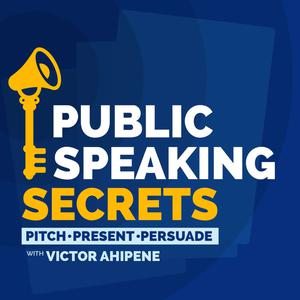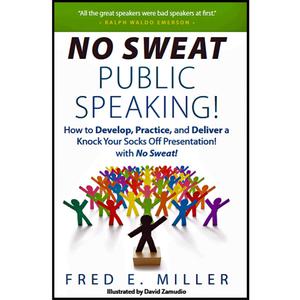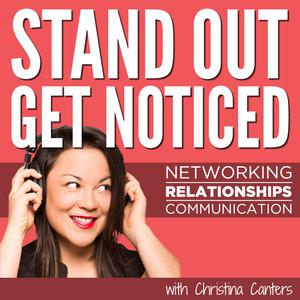
Fearless Presentations
Doug Staneart
Want to eliminate public speaking fear and become a more poised and confident presenter and speaker? Then Fearless Presentations is the answer. This podcast is based on our famous two-day presentation skills class offered in cities all over the world.
- 27 minutes 57 secondsCreate a Business Proposal Presentation
For the last few weeks, I've covered a number of topics about how to create great presentations. And on social media, I've received a few questions like, "What does a presentation design have to do with public speaking fear?"
The answer is simple. If you try to deliver a terrible speech to any audience, you'll be way more nervous. However, if you design a fantastic speech, you may never even get nervous in the first place. If your audience likes and respects your content, they will overlook a lot of minor glitches.
The opposite is true as well. If your presentation stinks, every minor glitch in your delivery will be exaggerated.
Last week, we covered a simple three-step process to help you deliver more persuasive speeches. This week, I will elaborate on that topic a little more. We will focus on a specific type of persuasive presentation - a proposal speech.
This can cover any type of business proposal, including sales presentations, presenting your ideas in a staff meeting or team meeting, or even something as simple as trying to get your boss to change vendors.
Remember that for most people, keeping the status quo is less risky than trying something new. So, these types of presentations need a little more finesse than just a normal informational presentation.
In this episode, I'll take you step-by-step through the process.6 May 2024, 12:00 pm - 31 minutes 25 secondsA Simple Three-Step Process to Help You Persuade Your Audience
For the last few weeks, I've covered techniques that you can use to design better presentations. We talked about ways to start a speech first. Then, we covered how to design a good presentation. Next, we covered how to end a presentation.
For the next couple of episodes, though, I'm going to share a few secrets about designing presentations that may also come in handy.
Today, I'll give you a very simple three-step process to help you make your presentations more persuasive. This simple process works very effectively if you are trying to sell an idea or a product to your audience.29 April 2024, 12:00 pm - 29 minutes 22 secondsAn Easy Way to Introduce Yourself When You Start a Presentation
For the last few episodes, I've shown you how to start a speech, how to design a speech, and, last week, how to end a speech. But before we end this series, I wanted to cover one often-overlooked part of creating a compelling presentation.
Today, I'm going to show you how to introduce yourself to an audience so that your presentation starts off on the right foot.
Remember, when you are speaking to a new audience, they don't know who you are, what you want from them, or why in hell they should even listen to you.
In this short session, I'll give you one of the best ways to establish your credibility to a new audience without sounding like you're bragging. In fact, if you do this really well, your audience will want to pay attention to the rest of your speech.22 April 2024, 12:00 pm - 23 minutes 45 seconds7 Professional Ways to End Your Speech
This week, we're continuing our series on how to design presentations that are more engaging for your audience. When your audience enjoys your speeches, they will give you positive feedback, which will boost your confidence.
A couple of episodes ago, I showed you a few fun ways to start a speech. Last week, I showed you a simple way to design a speech so you don't have to memorize the presentation word-for-word. And today, I'll cover a few ways to end your speech so you leave the audience wanting more from you.
Remember that the last thing you say in your delivery will be what your audience remembers. In this episode, I'll show you a few ways to help your audience retain the most important items from the speech. We'll also cover a few ways to end your speech so that the audience sees you as a credible authority on the subject.
Keep in mind that different speech ending techniques can have totally different value for the audience. So, pick a speech ending that best helps your audience get the most value from your presentation.15 April 2024, 12:00 pm - 22 minutes 21 secondsA Simple Way to Design a Presentation So You Are Less Nervous Presenting
Last week, we started a new series on how to design presentations that are more engaging for your audience. When your audience enjoys your speeches, they will give you positive feedback, which will boost your confidence.
Last week,, we covered seven ways to start your speech. Today, we'll cover a simple three-step process for designing a great presentation. When we teach presenters how to reduce nervousness when they speak, a major component of the process is designing a great speech in the first place.
For instance, what most people do is write out everything they know about a topic. Then, they make bullet points in a slideshow that cover every minute component of this knowledge. Really, though, these bullet points end up just being cheat notes for the presenter. This is a terrible way to organize a speech. The process also increases nervousness exponentially.
The process I cover in this episode is really simple and works in 90% of the presentations I've seen in my career. First, I'll help you narrow down your topic to just the things that the audience is most interested in right now. Next, I'll help you create just a few bullet points based on what is most important to the audience. Then, finally, I'll show you how to reinforce each point with content that is easy to deliver without memorizing a bunch of stuff.
Use this process to design your next speech, and you'll get a lot of positive feedback from your audience!1 April 2024, 1:00 pm - 31 minutes 58 secondsA Few Ways to Start a Presentation (Presentation Starters) to Win Over a Tough Audience
This week we're starting a new series on how to design presentations that are more engaging for your audience. When your audience enjoys your speeches, they will give you positive feedback. When that happens, you confidence will go up.
In this session, we'll cover a few different ways to start a presentation effectively. What most presenters find is that once they say the first couple of sentences, their nervousness drops pretty dramatically.
These seven presentation starters will help you win your audience over—even in the first couple of minutes of your presentation.
By the way, the episode is sponsored by FearlessPresentations.com. So if you are looking for a faster way to reduce public speaking fear or become a more persuasive speaker,
We have 2-day public speaking classes coming up in Chicago, Charlotte, Philadelphia, Los Angeles, Dallas, Atlanta, and Miami. For details, go to fearlesspresentations.com.25 March 2024, 12:00 pm - 25 minutes 42 secondsTips for Hybrid Workshops (Both In-Person and Virtual Attendees)
Last week, I recovered a few tips for better virtual training sessions where your entire group is participating through Zoom or Teams. This week, though, I'm covering tips to help you lead better hybrid training sessions. These are sessions where some of your team is sitting in a room with you while you teach, and others are participating virtually.
This type of workshop delivery is more challenging, but over the last few years, we've come up with a few simple tips to ensure everyone attending the meeting has a better experience. And, in the last 10 minutes of the episode today, I will tell you about a piece of technology that will revolutionize these types of meetings for you. So, stick around until the end. This product is a real game changer in hybrid meetings.
Show Notes: Tips for Hybrid Workshops (Both In-Person and Virtual Attendees)9 October 2023, 12:00 pm - 33 minutes 32 secondsBest Practices and Tips for Virtual Instructor-Led Training
The last few weeks I've been traveling around delivering a series of in-person training sessions all over the world. And I noticed that when I'm delivering this training in major urban areas like Washington DC, Chicago, New York, and the like, inevitably, my client will turn on a Teams meeting or Zoom meeting as I'm setting up.
In many of these cities, coming into the office is still somewhat optional. These poor meeting organizers are trying to include virtual team members in their training sessions as well.
So, this week, I want to go back and review a few tips we came up with during the pandemic that help make instructor-led virtual training sessions more interactive and meaningful. Then, next week, I'll show you how to best organize a hybrid meeting where some people are in-person and some are virtual.
Virtual, instructor-led training is here to stay. In the past few months, many instructors and trainers have had to adapt to a virtual world. Trainers who embrace virtual platforms and adapt the best have an advantage over those who don’t. So, I thought it might be a good idea to cover a few Virtual Instructor-Led training best practices. So in this session, I’m going to cover a few tools and tips for virtual instructor-led training. In addition, I’ll start with exactly what virtual instructor-led” training is and how it is different from other types of training.
Virtual Instructor-Led Training Tools and Tips.In this episode, we cover a few tips and best practices for your virtual training sessions. The closer you stick to these guidelines, the better your training sessions will be.
Just as an FYI, though… These are tools and tips for virtual training sessions. If you are organizing a virtual staff meeting or just need to “get your team on the same page,” you only need one tip. Keep the virtual meeting short. Virtual staff meetings should take 15 minutes to 30 minutes — tops. The moment you cross that 30-minute mark, retention, and morale both go down exponentially.
With that being said, if you are teaching or training a group over Zoom or Teams, these tips can help you increase retention and morale.
Show Notes: Best Practices and Tips for Virtual Instructor-Led Training2 October 2023, 12:00 pm - 25 minutes 15 secondsNothing Gets Sold Until the Story Is Told with Steve Multer
STEVE MULTER is a veteran corporate spokesman and trainer for more than 100
global brands, including Cisco, Panasonic, Siemens, Fujifilm, HP, NTT Data, and Bayer. He is known as the chief storytelling officer for these and other brands. I wanted to have him on as a guest to give us a few tips on how to become better storytellers and use stories as a way to communicate more effectively and create more persuasive presentations.
During the interview, Steve explains what a corporate story is. He also explains how the stories that we tell in presentations are almost identical to the marketing stories that big marketing companies develop for huge brands.
You can visit https://corporatestorytelling.com/guide and enter code soldtold23 to download the publication, 5 Paths to Passionate Storytelling eGuide. You can also sign up for Steve's Tuesday Tips & Tricks.25 September 2023, 10:00 pm - 16 minutes 8 secondsPresentation Coaching-Do I Need a Public Speaking Coach?
Do I need to get a presentation skills coach? Well, unfortunately, the answer is probably… It depends. A public speaking coach can be very helpful in certain situations. However, in many cases, a public speaking coach can also be a complete waste of time and money. (The process may actually make you more nervous as well.)
In this episode, I cover the pros and cons of public speaking coaching. I give you a few circumstances where hiring a good public speaking coach can be very helpful. We will also cover the situations where a presentation coach can be detrimental. Next, I’ll give you a few ways to find a high-quality speech coach. Then, finally, I will share with you a list of skills where presentation and executive coaching are most helpful.
The Pros and Cons of Public Speaking Coaching.You have a lot of options for different types of presentation training. The most common way to acquire practical tips is by reading posts or books and/or watching videos online. This option is very cost-effective. (In most cases, it is free.) The downside of this type of training is that you won’t get feedback or coaching. So, quite often, this type of training can take a long time. You can also develop bad habits that may be more difficult to correct later.
However, if you hire a good public speaking coach, feedback is built into the process. For instance, a coach can help you design a sample presentation. Then, you can practice delivering that presentation in front of the coach. Your coach will give you feedback so you can improve your delivery. So, when you hire a public speaking coach, you can speed up your learning process quite a bit. Your presentation coach may have years of experience mastering the skill that you want to improve in. This shortens your learning curve.
Show Notes: The Pros and Cons of a Public Speaking Coach18 September 2023, 1:00 pm - 30 minutesProper Conference Room Setup Makes Presenting Much Easier
Today, I'm covering the importance of proper room setup and how the room that you present in will either make you more nervous or help you deliver a better presentation. The way that you set up the room before you even say a word has a lot of impact on how well you present. It also will determine how you can interact with your audience.
The main thing, though, is that if your audience is comfortable, they can help you present better. If they are uncomfortable, or worse, if you make them participating in your presentation hard, the audience will not be on your side.
If you ever saw Men in Black with Will Smith, there is a scene where he goes for the MIB interview. All the interviewees are sitting in egg-shaped chairs. They then have to take a test. And for the next couple of minutes, they all try to take the test without a table. It's pretty funny, but it is also a good lesson about how important your room and venue are to the success of your speech.
Proper room setup for a presentation can actually improve your performance in front of a group.The downside is true as well. Improper conference room setup can actually make you more nervous and make delivering the presentation more difficult.
This post has two parts. Part one is about The Different Conference Room Styles. In that section, I’ll give you different conference room setup options with pros and cons of each. Then, in Part Two, I’ll give you the Best Practices for How to Set Up a Conference Room and how to set up a meeting room. These best practices will help you avoid some of the big mistakes that presenters make when they set up the tables, chairs, and audiovisuals for meetings.
11 September 2023, 1:00 pm - More Episodes? Get the App
Your feedback is valuable to us. Should you encounter any bugs, glitches, lack of functionality or other problems, please email us on [email protected] or join Moon.FM Telegram Group where you can talk directly to the dev team who are happy to answer any queries.
 Claim the Stage: A Public Speaking Podcast for Women
Claim the Stage: A Public Speaking Podcast for Women
 The Speaking Club: Mastering the Art of Public Speaking
The Speaking Club: Mastering the Art of Public Speaking
 Public Speaking Secrets
Public Speaking Secrets
 NO SWEAT Public Speaking!
NO SWEAT Public Speaking!
 Time to Shine Podcast : Public speaking | Communication skills | Storytelling
Time to Shine Podcast : Public speaking | Communication skills | Storytelling
 Stand Out Get Noticed
Stand Out Get Noticed